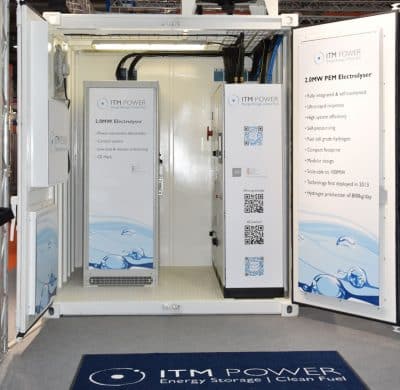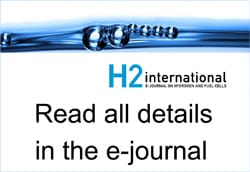This year’s June issue came with a detailed description of the electrolyzer market and in-depth reports on manufacturers and their products. But of course, the list wasn’t exhaustive, as numerous businesses have entered the segment and much had to be left unsaid. Many of those suppliers exhibited at Hannover Messe, showcasing their latest developments. Considering the great interest in our previous article on the technology, we thought to create a summary of the most recent electrolyzer news for our readers, a sequel if you will.
Demand and supply on the electrolyzer market are growing. Not only is the number of manufacturers increasing, but the capacity range of the devices is rising as well. One example is HydrogenPro, a Norwegian-based manufacturer founded only four years ago. It used Hannover Messe to unveil a large-scale design based on alkaline electrolysis. This system would reportedly provide 800 normal cubic meters of hydrogen per hour at 30 bars of outlet pressure and require 4.4 kilowatt-hours per normal cubic meter, a comparatively low number for an installation of that size (see also electrolyzer overview in June 2017 issue).
Hans Jörg Fell, CTO of HydrogenPro since early 2017, said that the “world’s largest electrolyzer” made it possible to produce even 1,000 normal cubic meters an hour. The benefits of such a large installation were a comparatively high efficiency at relatively low cost. Production was around 20 percent less expensive than with PEM electrolysis, and system costs added up to around USD 2 million, depending on the precise configuration – half as much as for installing a same-sized PEM unit.
…
With GreenHydrogen, founded in 2007 in Denmark, there was yet another Hannover Messe exhibitor hailing from northern Europe. Its first-ever H2 installation had been for a small railroad operation on the island of Samso. Today, the A series of its HyProvideTM units, developed in cooperation with Siemens, produces 20, 40 or 60 normal cubic meters of hydrogen per hour at a pressure of more than 30 bars, with hydrogen purity at 99.998 percent by volume. If combined, these alkaline units are said to have a capacity of up to 1,200 normal cubic meters per hour (5 megawatts). GreenHydrogen’s CEO, Niels-Arne Baden, told H2-international: “One main and exceedingly crucial aspect of the design was the development of highly efficient and durable platinized electrodes that offer very high current densities. During high-voltage and accelerated life tests, Siemens did not detect any degradation under an electron microscope even after the 10,000-hour milestone.” He added: “HyProvide will be offered on the market in early 2018.”
Areva H2Gen exhibited a 60-megawatt design based on a 10-megawatt module and a 2-megawatt stack. These specifications confirmed that Areva, whose systems come from a factory owned by its French parent company and located near Paris, was primarily interested in big systems producing large amounts of H2 – particularly at refueling stations for buses.
Meanwhile, Giner is gradually turning away from stack-only manufacture toward system integration. Before this year’s Hannover Messe, it announced in April 2017 that it would create a spin-off called Giner ELX specializing in large hydrogen generators (5-megawatt modules) for renewable storage and other industrial uses. So far, Giner stacks have been utilized in projects in the United States, India, Spain, France and at carmaker Audi in Germany.
Giner’s CEO, Andy Belt, explained: “The formation of Giner ELX builds on Giner’s successful commercial PEM electrolysis business. We are focusing the ELX team on developing the lowest cost and highest performance grid-level energy storage solutions on the market.” Hector Maza, VP business development at Giner, said that his company would be able to offer hydrogen at USD 4 per kilogram by 2020; the relevant agreement with the DOE had already been concluded. He also explained that Giner products had already achieved 350 bars of pressure directly in the electrolyzer and that the company was seeking to up compression to 900. In Hanover, the exhibit included the prototype of a 5-megawatt PEM electrolysis stack.
…
ITM Power, a now established and growing energy supplier and electrolyzer manufacturer based in Sheffield, UK, is aiming for the same capacity range. It has also been trying for a long time to enter the markets of mainland Europe, but has had to grapple repeatedly with bureaucracy at its finest. From ITM’s German subsidiary in the state of Hesse, Phil Doran attempted for years to win orders for the British-based parent company – with little success. The only exception was a 360-kilowatt power-to-gas plant at Thüga in Frankfurt am Main. While Calum McConnell, who followed in his footsteps in the fall of 2016, has continued Doran’s efforts, H2 Mobility has already made it clear that the establishment of a German hydrogen infrastructure would happen without electrolyzer-based systems and two of its own stakeholders, Air Liquide and Linde, would receive the lion’s share of orders.
In Hanover, ITM exhibited two container units replete with electrolyzer technology. Graham Cooley, ITM’s CEO, said …
Norwegian-based Nel Hydrogen – which celebrated its 90-year anniversary in Hanover – and US-based Proton OnSite had two separate booths despite the former having acquired the latter at the beginning of this year. Nel reported on the 400-megawatt plant it was designing in partnership with one of its customers from industry and said that such a large project would cut investment costs to as little as USD 450 per kilowatt.
…
Hydrogenics shows 3-megawatt stack
On the second day of Hannover Messe, Hydrogenics presented its new 3-megawatt PEM stack Hylyzer 600 developed in Canada. This next-generation device is the successor to a 1.5-megawatt module shown a few years ago. Bernd Pitschak, managing director of Hydrogenics’ German subsidiary, stressed in his short speech that the unit was notably more compact than the previous model (620 normal cubic meters per hour at more than 30 bars of pressure), a possibly essential factor in larger systems. He explained that the plant footprint (55 x 88 x 115 centimeters or 21.7 x 34.6 x 45.28 inches) “really was a problem” in general, as an increase in size would often have costs rise as well. For example, bus operators in California had only been able to fill up one, two or maybe three vehicles, whereas the new stack would make it possible to use the same space for supplying 20 to 30 buses or 280 cars each day.
McPhy had something new in store too: a complete fill-up unit called SimpleFuelTM. Developed in the United States in partnership with Ivys Energy Solutions und PDC Machines, it comes with an integrated electrolyzer and storage system, can fill up cars at 350 and 700 bars, and – while originally developed for the State-side market – is currently being adapted to meet European standards. The station isn’t the quickest considering its capacity of 5 to 10 kilograms per day, but rather an “inexpensive entry into the hydrogen world,” that would require “only water and power hookups,” as McPhy put it. It is an all-in-one system combining H2 production (purity: 99.999 percent by volume), compression, storage and supply in one single device.
…
GP Joule and H-Tec
GP Joule based in Reußenköge, Germany, has gotten greatly involved in energy storage projects, marketing and policy. As many as four booths at Hannover Messe were used to exhibit GP products and several electric cars, and the employees attending the trade show were running around with the same-color pair of gray sneakers. And in mid-May 2017, the managing directors of GP, Heinrich Gärtner and Ove Petersen, inaugurated a new office in Berlin.
…
Even the former managing director of H-Tec, Stefan Höller, was a guest at the joint booth. He told H2-international that he had meanwhile launched his own start-up, Hoeller Electrolyzer. After GP Joule took over H-Tec in late 2015, his exit had already been decided, but he left the company only late last year. Soon thereafter, in December 2016, he founded his new consulting business – again, based in Lübeck. He said his aim, in partnership with interested plant equipment suppliers, was to promote particularly the use of wind power plants for hydrogen production. Their subsidies will run out at the end of this decade.
thyssenkrupp and Siemens
All previously mentioned businesses exhibited at the joint booth Hydrogen + Fuel Cells + Batteries. Directly next to it in hall 27, at the shared exhibition space of North Rhine-Westphalia, attendees could find another electrolyzer business, thyssenkrupp Uhde Chlorine Engineers. The Dortmund-based department of the thyssenkrupp corporation presented a large cell that was typically used in industrial-scale electrolysis and pointed out its expertise from worldwide over 600 electrolysis installations totaling more than 10 gigawatts.
At Siemens’ Hanover booth, Gabriele Schmiedel, head of the Hydrogen Solutions business unit, made it unmistakably clear that the new strategy was to “think big, act bigger.” The Silyzer 200 prototype had still been installed at Energiepark Mainz (see Power-to-gas is now en vogue in Europe); its commercially available version with 1.25 megawatts came online in fall 2016 in Hassfurt. Additionally, four units with a combined capacity of 5 megawatts are being set up in northern Germany at a refinery. And the latest device generation, the Silyzer 300 with 6 megawatts, is reported to be installed in Linz, Austria, on the premises of a steel factory (see next issue). The new target beyond 2020 was somewhere above 100 megawatts, Schmiedel said.
The hydrogen from Mainz and Hassfurt is used by Greenpeace Energy for gas grid feed-in sold as proWindgas, just as in Prenzlau. The energy supplier will up H2 production from 989 to presumably around 2,600 megawatt-hours between 2016 and 2017. Greenpeace Energy’s CEO, Nils Müller, said: “Eco-wind gas could enjoy much greater success if unfair market barriers weren’t slowing us down.”
…
Käppner returns to hydrogen industry
In July 1, 2017, Roland Käppner became thyssenkrupp’s new head of Energy Storage and Hydrogen, a department of the corporation’s Industrial Solutions business area. The aim is to seek out new business opportunities in the rapidly growing renewables industry.



























This development is struggling along since the 1990s.
We should better think now: Ar we on the right path
or do we have to go on another track(s)?
Here are my proposals how to proceed:
https://www.youtube.com/watch?v=Tk7B8wpr6qg
Can the hydrogen produced by these electrolyzers be used to generate electricity?
Can the water, infused with hydrogen by these electrolyzers, be drinkable?
Yes, the hydrogen can be used in fuel cells for example.
Yes, the water is clean. But there are no minerals in it so it should be mineralized before drinking.
Thank you for your quick response.
How much did the 100MW unit cost in total? What Purity must the water be? Is it a closed system? What is its lifespan and maintinence schedules like?
@Vladimir, if all people would continue to aks such questions,
mankind would still live in the woods on trees.
See my example for the development in the aircraft industry here: http://www.hydrogenambassadors.com/background/35-locomotives-could-not-fly-or-evolution-in-the-aircraft-industry-1903-2007.php
Nice Article
Hydrogen Puriy Analyzer : Vasthi Portable Hydrogen Purity Gas Analyzers Model VHP- 200 is a light weight, easy to handle, battery-powered analyzer, used to verify measurements and for spot-checking when other methods provide questionable results.